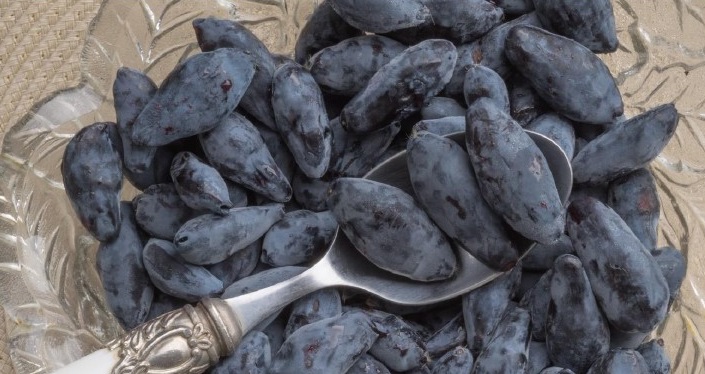July
Should be ready for picking in the next couple of years!
Picking & Handling:
Haskaps are considered easy to pick. Haskaps can be eaten freshly picked or frozen for later use. When the frozen fruit is placed in the mouth, it melts away. Seeds aren’t noticeable when eating and the skins simply disintegrate.
Haskaps work well in vinaigrettes, jams, pies, baking, pastries, wines, juices, sauces, yogurt, candies, for ice cream toppings, on salads or meats (such as pork roast), and in smoothies.
Nutritional Information:
| Calories (kcal) | Potassium (mg) | Calcium (mg) | Phosphorus (mg) | Iron (mg) | Vitamin A (ug) | Vitamin C (ug) | Vitamin E (ug) |
| 53 | 190 | 38 | 25 | 0.6 | 130 | 44 | 1.1 |
(per 100 grams of fruit)
Haskaps provide exceptionally high levels of antioxidants – up to three times that of a blueberry. Antioxidants are capable of counteracting the damaging, but normal, effects of the physiological process of oxidation in animal tissue. Antioxidants are nutrients (vitamins and minerals) as well as enzymes (proteins in your body that assist in chemical reactions). Antioxidants are believed to help prevent chronic diseases such as cancer, heart disease, stroke, Alzheimer’s disease, Rheumatoid arthritis, and cataracts. Haskaps are a great source of polyphenols, antioxidants and other flavonoids such as Rutin, Ferulic acid, Epicatechin, Genistic acid, Protocatechuic acid, Caffeic Acid, Ellagitannins, Quercetin and many others which could potentially help fight cancer and other diseases. Haskap berries possess extremely high antioxidant capacities.
Vitamin C is an antioxidant that potentially helps to neutralize free radicals responsible for many chronic diseases. It is also responsible for the production of a protein called collagen, which could help slow down the signs of aging and can speed up recovery of healing wounds with less visible scars. Vitamin C also plays a vital role in protecting your heart health. Haskap berries have higher vitamin C content than oranges and blueberries.
Potassium is a mineral that is needed for your body to work properly. Potassium is a very significant body mineral, important to both cellular and electrical function. It is one of the main blood minerals called “electrolytes” (the others are sodium and chloride). Our bodies use potassium to build proteins, breakdown and use carbohydrates, build muscle, maintain normal body growth, control the electrical activity of the heart, and control the acid-base balance. Potassium is particularly important for those with high blood pressure, heart failure, or heart rhythm problems and a diet high in potassium is important for hypertension. Haskap berries have the second highest levels of potassium after bananas.
Facts:
Haskaps are a member of the honeysuckle family. Haskaps are described as having a sweet, tangy, zing flavour that most people say is a cross between a blueberry, raspberry, and saskatoon. Haskaps have long been known by the ancient Japanese as the fruit of life longevity and the fruit of vision.
Haskap berries grow on shrubs. The shrubs have oval green leaves with a slightly waxy texture. The flowers are yellowish-white and are produced in pairs on the shoots. The berries themselves are blue-coloured and elongated in shape. The seeds are very small. Haskaps are researched in Canada at the University of Saskatchewan Fruit Breeding Program. Haskap shrubs grow well in the cold climates of Canada with short growing seasons.
Our Haskaps:
We planted 100 haskap shrubs in the spring of 2015, expecting them to be ready for picking in 2017. However less than half of those survived and those that did survive are still quite small and so we are not expecting them to be ready for picking for another couple of years. Haskaps require two different varieties be planted together as companion varieties so that they can cross-pollinate each other.
In 2015 we chose to plant the Tundra and Aurora haskap varieties. The Tundra has a medium sized berry (approximately 1.49 grams) which is described as sweet and tart flavoured, whereas the Aurora has a large berry (approximately 2.17 grams) which is described as very sweet. Tundra haskaps are firm, allowing for ease of picking, but tender enough to melt in the mouth. Aurora haskaps are considered easy to pick and very sweet. Aurora haskap bushes are considered more productive and the berries are one of the largest and sweetest and best tasting available.
Because many of those plants did not survive, we waited until new varieties were available before planting more in the spring of 2018. We planted 500 of the Boreal Blizzard and 500 of the Boreal Beast varieties in June 2018. Aurora and Boreal Blizzard are closely related varieties. The Boreal Blizzard is one of the largest varieties available (average 2.8 grams) and has been described as having a sweet tangy taste. The Boreal Beast yields slightly smaller berries (average 1.8 to 2 grams) than the Boreal Blizzard. The Boreal Beast is known for a great aroma and aftertaste.
Boreal Blizzard:

Boreal Beast:

Tundra shape
Aurora shape
(Photos courtesy of University of Saskatchewan Fruit Program)

